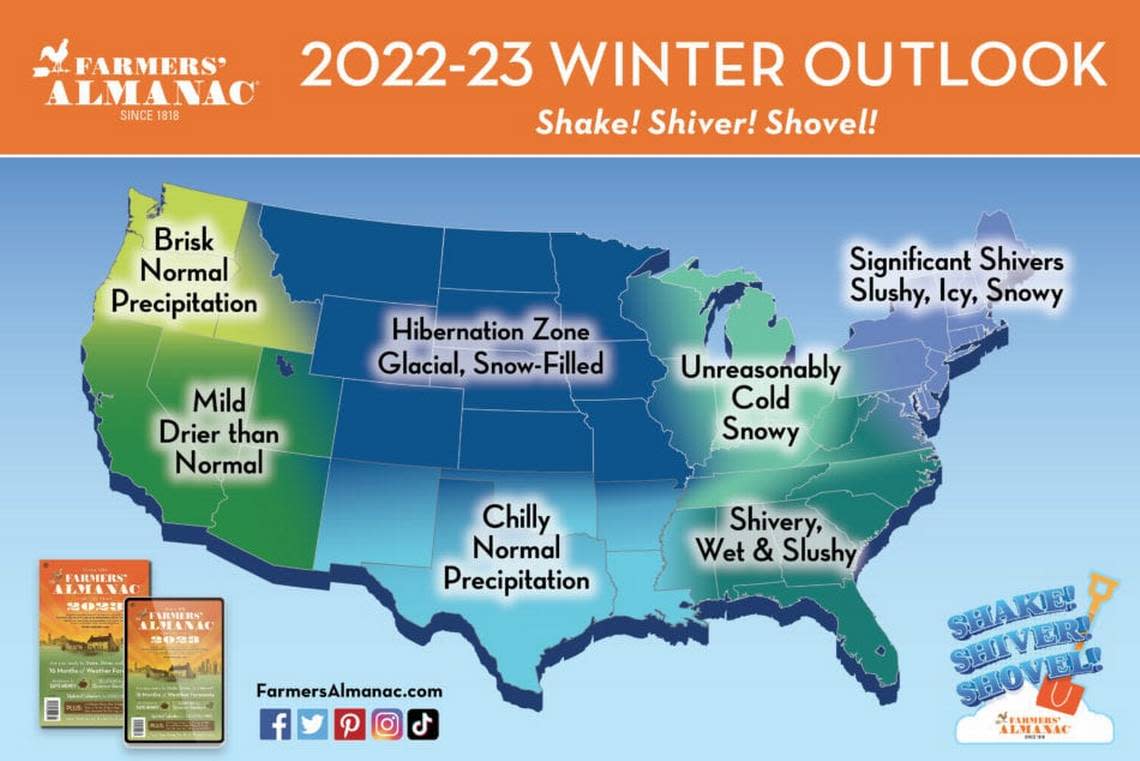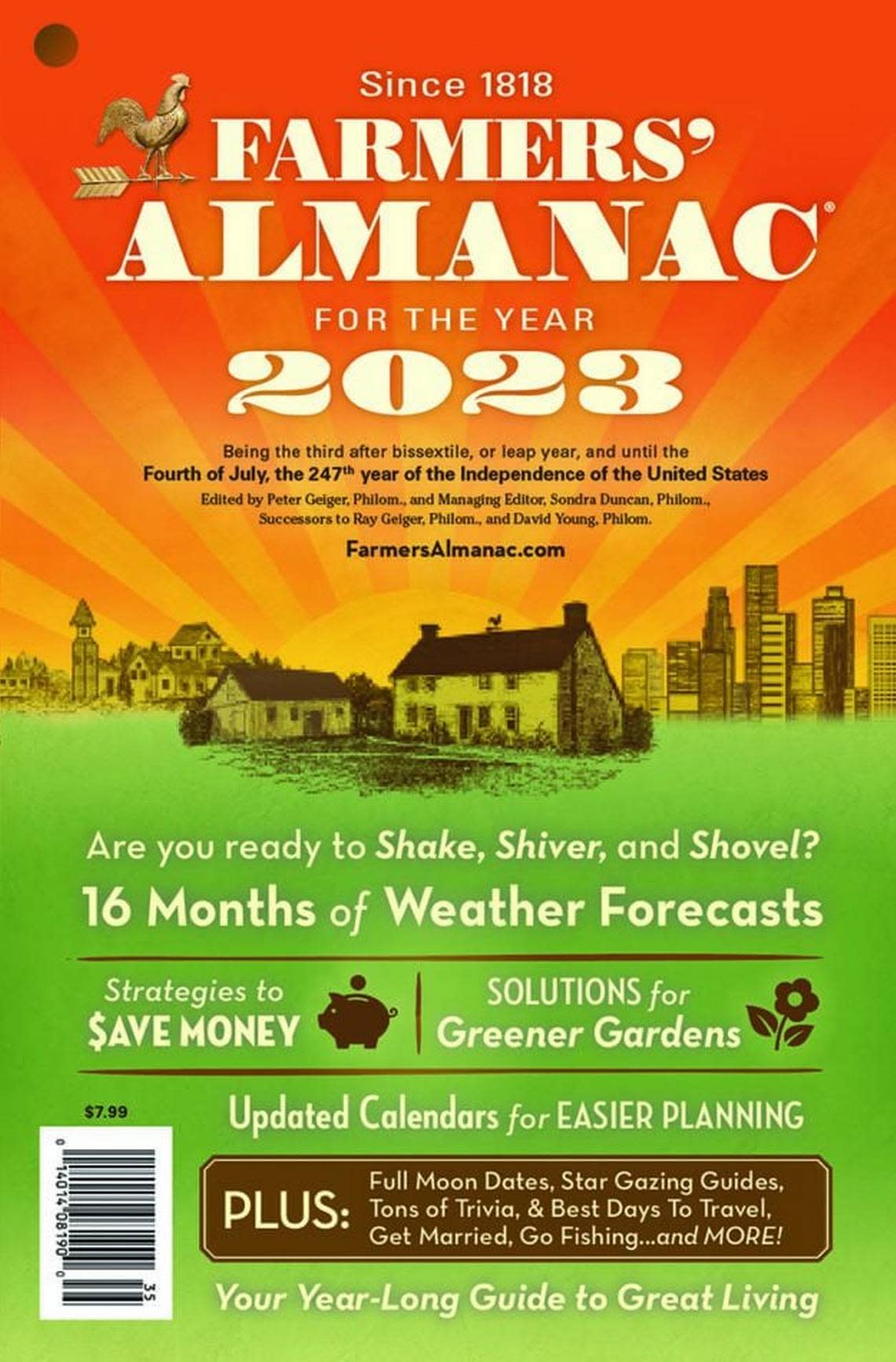Farmers’ Almanac has forecast weather for the next year for Florida. Beware Columbus Day
The new Farmers’ Almanac is out and has it got news for weather watchers.
For Floridians and much of the U.S. southeast zone, there’s going to be a “turbulent transition to warmth after winter” — winter being what it is in Florida, mind you. When the made-in-Miami Latin freestyle pop group Expose’ sang “Seasons Change” back in 1987, the women weren’t referring to their hometown.

“Spring will be unusually active over the nation’s heartland with frequent heavy to severe thunderstorms predicted. Such adverse activity will be confined chiefly to the Southeast states in March, then will spread north and west,” the newly released Farmers’ Almanac 2023 edition said.
Spring 2023 will also be much warmer than normal for most of the nation and persist from late June through early September, with temperatures in the 90s and heat indices in the triple digits, the Farmers’ Almanac warns.
This dovetails with a new study released earlier this month by the nonprofit climate research group, First Street Foundation, that found that “Miami-Dade leads the nation as the county that could see the sharpest increase in dangerous hot days over the next 30 years, when the U.S. could be an average of 3 degrees hotter,” the Miami Herald reported.
“The Southeast, including Florida, is likely to see much higher temperatures more frequently. That means extra weeks of the year where temperatures top 100 — or even higher,” according to the report.
READ MORE: Dangerous ‘extreme heat’ days to multiply in South Florida, study finds.
Hurricanes and holiday predictions
As for hurricanes, if you have booked an outdoor barbecue for Columbus Day weekend for next year, Oct. 7-9, 2023, read on:
▪ “Our long-range forecast suggests a hurricane threat from the Gulf Coastal States northeast to the mid-Atlantic Coast sometime in the third week of August [2023], another hurricane threat for the Atlantic Seaboard around equinox time in September [2023], and yet another threat along the Southeast Coast, coinciding with the [2023] Columbus Day weekend,” the Farmers’ Almanac predicts.
Ahead of that glimpse of next year’s Columbus Day, the almanac goes into further detail in its forecast for the southeast zone, beginning in September 2022. Here’s some of what the Farmers’ Almanac suggests:
▪ The Atlantic seaboard faces a hurricane threat on Sept. 12-15, 2022. Also, heavy rains thanks to an intensifying low pressure disturbance moving off the Atlantic coast on Oct. 8-11., 2022
▪ “Fair skies for trick-or-treaters” around Halloween on Oct. 28-31, 2022.
▪ Mostly cold with fair skies for the Thanksgiving holiday on Nov. 24-27, 2022.
▪ Showers for Christmas 2022.
▪ “Unreasonably cold air plunging south out of Canada” on Jan. 20-23, 2023.
▪ “A big warmup” for Presidents’ Day weekend on Feb. 16-19, 2023.
▪ Squally weather along the Gulf Coast on June 20-23, 2023.
▪ And plenty of thunderstorms and “oppressive” humidity in many of the months to come, including summer 2023.
But, hey, tell us something we don’t already know from our sweat-drenched clothes on Thursday, Aug. 25, 2022, when it was already 90 before 11 a.m. with a heat index expected to hit 101 degrees — what you will really feel — according to the National Weather Service in Miami.
But as the page’s author, the pseudonymous Caleb Weatherbee, closes, “As we see how the winter weather unfolds this upcoming year, keep in mind this quote from Shakespeare: ‘In nature’s infinite book of secrecy, a little I can read.’”
Hurricane season heats up earlier and earlier. New study suggests climate change is why
Forecasting for centuries

Long before Twitter, 24-7 weather reports and even the National Weather Service in Miami, the Farmers’ Almanac has predicted long-range weather information for the United States since 1818. James Monroe was the fifth U.S. president when it first published in 1818.
“I’ve worked on the Farmers’ Almanac with my dad since 1979 and along with Sandi Duncan (managing editor) since 1995,” Farmers’ Almanac editor Peter Geiger told the Miami Herald in an email interview from his office in Maine.
“We do our weather two years in advance,” Geiger said. “When you look at the Miami area, it is a ho-hum winter by snow and cold standards. If I was in Miami, I’d look at the rest of the country because northerners can only take so much cold before they head to Florida and Arizona. We label the north central states as the ‘hibernation zone’ with significant cold and snow all winter. The Mid-west and Northeast will feel winter as we lay out in our predictions.”
Geiger pointed out several items from the weather section in the 2023 Farmers’ Almanac:
“September 12–15 [2022], hurricane threat along the Atlantic Seaboard. Don’t know if that means Miami,” he said. “We talk about several cold spells in November and December. ... Spring [2023]— unusually active with lots of rain, thunderstorms and more in the southeastern part of the US. On the map we say, ‘Near normal temps with tons of showers.’ Summer — oppressive, showery, thundery.”
Geiger summarized the purpose of the Farmers’ Almanac by citing the note on his editor’s page that reads, “One of life’s secrets is to figure out how to achieve balance in your life. We know it can be challenging to find the time to step back and smell the flowers. So, we offer suggestions and inspiration for how to slow down, as well as what to do when your days are so busy.”
The ‘old’ Farmer’s Almanac
What about that other Farmers’ Almanac, the “old” Farmer’s Almanac? The Harris Farmer’s Almanac — with its tan cover and different usage of the apostrophe on Farmer’s — was first published in 1792 when George Washington was president and based on the original Harris’ Almanack first published in 1692, according to its cover.
The “new” Farmers’ Almanac, the 1818 one, has an orange-and-green cover.
The old Harris Farmer’s Almanac also released its 2023 edition in August.
Both almanacs are carried in stores like Publix, Dollar General, Barnes & Noble, Sam’s Club, Winn-Dixie, Walmart, Walgreens and others.
The 2022 old Harris Farmer’s Almanac said our summer this year will be “hotter and slightly drier than normal.” That jibes. We have had back-to-back heat records set this August.
8/18 6:30PM: ️Another day, another temperature record broken at MIA! PBI also tied its previous high temp record of 96F set back in 1949! Temperatures across South FL will remain warm overnight, and could reach the mid 90s again tomorrow, with heat indices in the low 100s. #flwx pic.twitter.com/zP85VE6Rdx
— NWS Miami (@NWSMiami) August 18, 2022
“September and October will be slightly warmer and much drier than normal, with the hottest period in early September,” the “old” Harris Almanac said for Miami in 2022.
The new Harris Almanac forecasts slightly above normal temperatures in November 2022, May and August 2023. Slightly below normal temperature in December 2022 and February 2023, along with a few severe storms likely in February. And near normal temperatures in January, March, April, June, July, September and October 2023.
Your Independence Day parades on July 4th in South Florida will be among the hottest parts of July 2023, the Harris Almanac notes.
“Oppressive heat and humidity,” Geiger’s new Farmers’ Almanac says about the coming Fourth of July.
That Columbus Day weekend, the one the Farmers’ Almanac says could face a hurricane threat? The Harris Almanac said it will be “cooler with slightly more precipitation.”
Hurricanes can bring precipitation, just saying.
How the almanacs forecast weather
Are there differences in the two almanacs? They’d be subtle, Maine country station Q-106.5 reported in 2021, citing Infographic Journal.
Both take into account solar activity.
The Harris Almanac looks at prevailing weather patterns and meteorology. The Geiger Almanac’s mathematical formula takes into account lunar activity and the planet’s positioning, as well.
The Harris Almanac incorporates satellite data, jet stream patterns and ocean temperature. The Farmers’ Almanac that Geiger publishes does not use satellite tracking equipment when forecasting. Both claim about 75% to 85% accuracy.
Meteorologists, like those at the National Weather Service, are generally skeptical about forecasts that extend beyond 10 days in the future.
“For what meteorologists do — being very specific to local locations, I agree,” Geiger said. “It is difficult to predict 10 days out. In our case, our first editor, David Young, was a mathematician, calculator and an astronomer. He wanted to predict weather for farmers. He developed a formula that is applied to sunspot activity, planet positions and impact of the moon.
“In our 206 years, we have had only seven prognosticators, which I believe has helped with what we do,” Geiger said. “We break the country in regions and make our predictions of two-to-three day segments. Is it specific enough? I think so. If someone is getting married in July, planning a vacation, etc. we serve that purpose.”
It’s getting moist in the tropics. What does that mean for Florida’s weekend weather?

